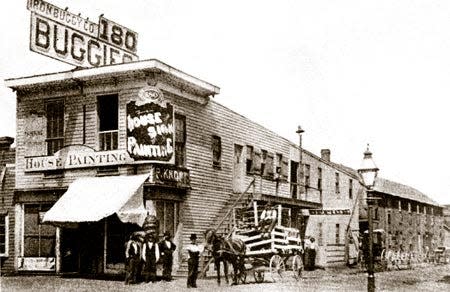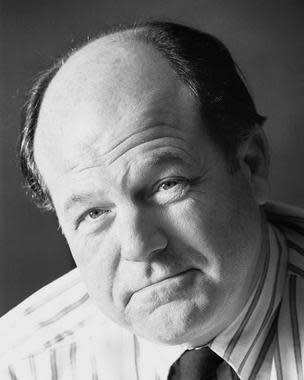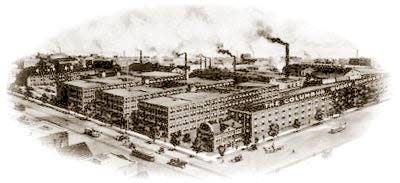As It Were: Columbus once was the buggy capital of the world

Columbus is a city that prides itself on diversity.
The town is not only the state capital; it also is the home of the state’s largest university.
And the economy of Columbus is diverse, as well, with people working in commerce, trade, education and state service, with only about one worker in five in manufacturing.

Such was not always the case. In the late 1800s, Columbus had made a bid to become a major manufacturing center. And the product to be made was the buggy.
Making horse-drawn buggies from local materials was not new in Columbus. The city, founded to be the state capital in 1812, was home to a number of local makers of carriages in the years after the Ohio and Erie Canal and the National Road arrived in the city in the early 1830s. But the vehicles were made individually by local smiths and carpenters and not in large numbers or at modest expense.
All of that changed in the 1850s, and some of the people who could see the possibilities best were the Peters brothers.
The father of George and Oscar Peters came to Columbus in the 1830s and established his family in a tannery on the ravine carrying a town creek of some size immediately south of the county courthouse. In time, the Peters Tannery and its rather smelly business gave the creek the new name of Peters Run. It was along the creek that the Peters brothers had grown up to become rather expert in making leather goods from the products of the tannery. Among these goods were leather trunks and leather dashboards for carriages.
Unlike the rest of the family who wanted to simply stay in the tannery business, George and Oscar attended business classes at local schools and worked for a variety of companies and enterprises. By the mid-1850s, the brothers understood that Columbus was a good place to make things and in the 1860s opened a business making buggies.
The business was modestly successful. Supplies of coal, iron and wood were available, and the arrival of railroads in the 1850s permitted finished products to be shipped economically. By 1870, they had sold about 100 buggies at auction but were looking for new opportunities. They found them in two ways – with a person and a plan.
The person was Clinton D. Firestone, a Canton native who had operated a railroad in Iowa but had been looking to Ohio to make his fortune. He met with the Peters brothers, and the three decided to go into the buggy business. Their plan was centered on the success of the newly completed Hocking Valley railroad, which could provide immense quantities of wood, iron and coal to Columbus industries at very low prices.
Their first venture was called the Iron Buggy Co. and in 1870 was in a cheap, 2-story frame building at High Street and Hickory Alley. A single-frame design combined with inexpensive labor created a buggy that could be sold for $150. In their first year, they sold 237 buggies.
The factory building burned in 1874 but quickly was rebuilt by the brothers. In 1875, perhaps intending to try something a little different from iron buggies, they sold the business to H.K. Tuller of the Buckeye Buggy Co. In 1875, Firestone and the Peters brothers organized the Columbus Buggy Co. with an initial capital of $20,000.

Using inexpensive materials and a simplified version of what today would be called an assembly line, the company was quite successful. In 1878, the company employed 250 people and made 100 buggies a week. In 1883, the company employed 1,000 people and was making 25,000 buggies a year. By 1888, the company’s buildings took up an entire city block between High and Wall streets.
A relative of C.D. Firestone, Harvey Firestone worked for Columbus Buggy for a time and took the lessons he had learned in Columbus to form his own company, Firestone Rubber, in Akron, making solid rubber tires for carriages.
Oscar Firestone died in 1894, followed by George Firestone in 1897, but Clinton Firestone and the managers they had made carried on. In 1903, the company entered the automobile business with an electric car. In 1908, they contracted with auto designer Lee Frayer to create a gasoline car. It was called the Firestone-Columbus, and its test driver was a local boy named Eddie Rickenbacker.
Unable to compete with even more economical producers like Henry Ford with his Model T and devastated by damage from the Flood of 1913, Columbus Buggy was closed in 1914. C.D. Firestone died that year.
At its peak, Columbus Buggy was one of more than 22 buggy companies based in Columbus. One in every six carriages made anywhere were made in Columbus.
Soon all of those companies were gone. A few of the Columbus Buggy factory buildings survived as commercial structures, and one is a residential unit called the Buggyworks. It keeps alive a little of the memory of a once great industry.
Local historian and author Ed Lentz writes the As It Were column for ThisWeek Community News and The Columbus Dispatch.
This article originally appeared on ThisWeek: As It Were: Columbus once was the buggy capital of the world
